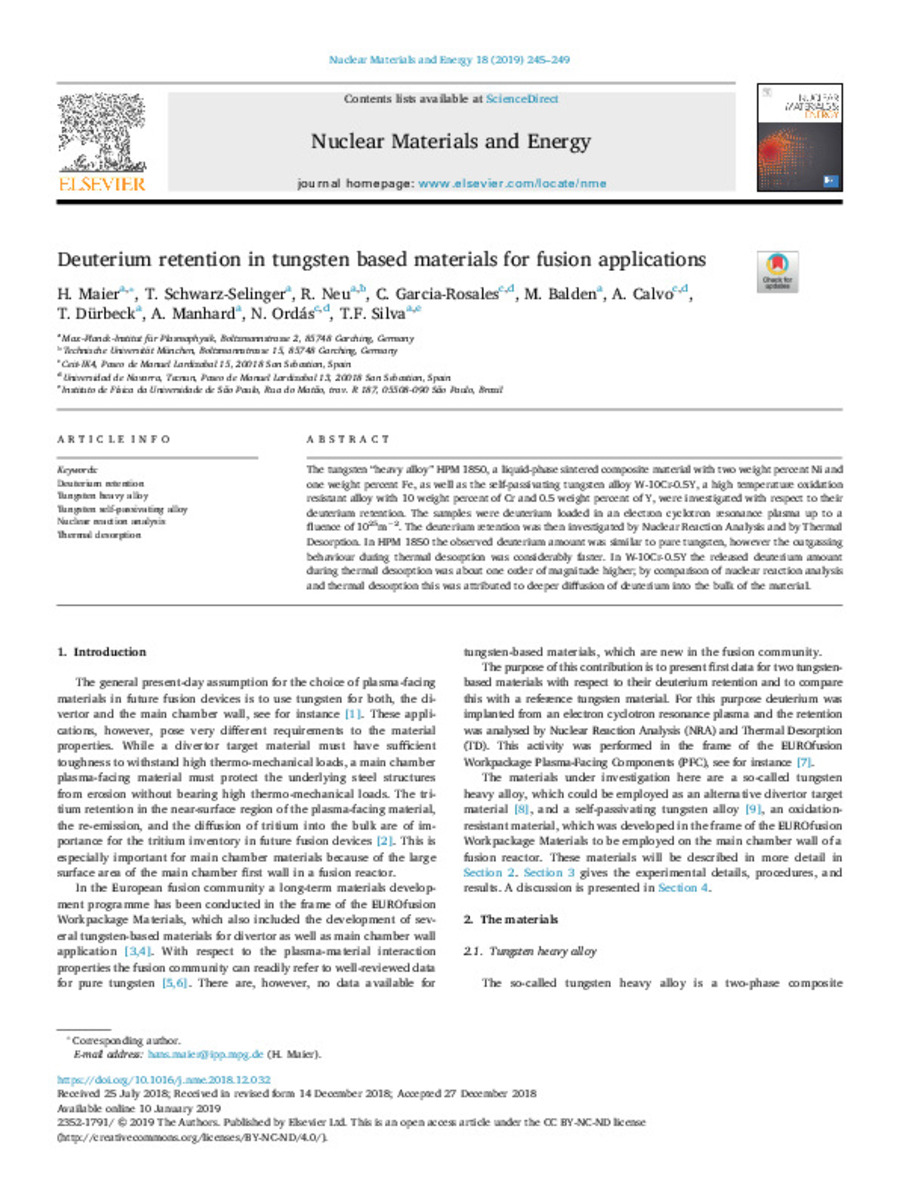Full metadata record
| DC Field | Value | Language |
|---|---|---|
| dc.creator | Maier, H. (H.) | - |
| dc.creator | Schwarz-Selinger, T. (T.) | - |
| dc.creator | Neu, R. (R.) | - |
| dc.creator | Garcia-Rosales, C. (Carmen) | - |
| dc.creator | Balden, M. (M.) | - |
| dc.creator | Calvo-González, A. (Alfonso) | - |
| dc.creator | Dürbeck, T. (T.) | - |
| dc.creator | Manhard, A. (A.) | - |
| dc.creator | Ordas-Mur, N. (Nerea) | - |
| dc.creator | Silva, T.F. (T. F.) | - |
| dc.date.accessioned | 2022-01-19T07:21:13Z | - |
| dc.date.available | 2022-01-19T07:21:13Z | - |
| dc.date.issued | 2019 | - |
| dc.identifier.citation | Maier, H. (H.); Schwarz-Selinger, T. (T.); Neu, R. (R.); et al. "Deuterium retention in tungsten based materials for fusion applications". Nuclear Materials and Energy. 18 (2019), 2019, 245 - 249 | es |
| dc.identifier.issn | 2352-1791 | - |
| dc.identifier.uri | https://hdl.handle.net/10171/62745 | - |
| dc.description.abstract | The tungsten “heavy alloy” HPM 1850, a liquid-phase sintered composite material with two weight percent Ni and one weight percent Fe, as well as the self-passivating tungsten alloy W-10Cr-0.5Y, a high temperature oxidation resistant alloy with 10 weight percent of Cr and 0.5 weight percent of Y, were investigated with respect to their deuterium retention. The samples were deuterium loaded in an electron cyclotron resonance plasma up to a fluence of 1025m−2. The deuterium retention was then investigated by Nuclear Reaction Analysis and by Thermal Desorption. In HPM 1850 the observed deuterium amount was similar to pure tungsten, however the outgassing behaviour during thermal desorption was considerably faster. In W-10Cr-0.5Y the released deuterium amount during thermal desorption was about one order of magnitude higher; by comparison of nuclear reaction analysis and thermal desorption this was attributed to deeper diffusion of deuterium into the bulk of the material. | es_ES |
| dc.description.sponsorship | This work has been carried out within the framework of the EUROfusion Consortium under EUROfusion WP PFC and has received funding from the Euratom research and training programme 2014–2018 under grant agreement No 633053. The views and opinions expressed herein do not necessarily reflect those of the European Commission. | es_ES |
| dc.language.iso | eng | es_ES |
| dc.publisher | Elsevier BV | es_ES |
| dc.relation | info:eu-repo/grantAgreement/EC/H2020/633053/EU | - |
| dc.rights | info:eu-repo/semantics/openAccess | es_ES |
| dc.subject | Deuterium retention | es_ES |
| dc.subject | Tungsten heavy alloy | es_ES |
| dc.subject | Tungsten self-passivating alloy | es_ES |
| dc.subject | Nuclear reaction analysis | es_ES |
| dc.subject | Thermal desorption | es_ES |
| dc.title | Deuterium retention in tungsten based materials for fusion applications | es_ES |
| dc.type | info:eu-repo/semantics/article | es_ES |
| dc.description.note | Published by Elsevier Ltd. This is an open access article under the CC BY-NC-ND license (http://creativecommons.org/licenses/BY-NC-ND/4.0/). | es_ES |
| dc.identifier.doi | 10.1016/j.nme.2018.12.032 | - |
| dadun.citation.endingPage | 249 | es_ES |
| dadun.citation.number | 2019 | es_ES |
| dadun.citation.publicationName | Nuclear Materials and Energy | es_ES |
| dadun.citation.startingPage | 245 | es_ES |
| dadun.citation.volume | 18 | es_ES |
Files in This Item:
Statistics and impact
Items in Dadun are protected by copyright, with all rights reserved, unless otherwise indicated.






